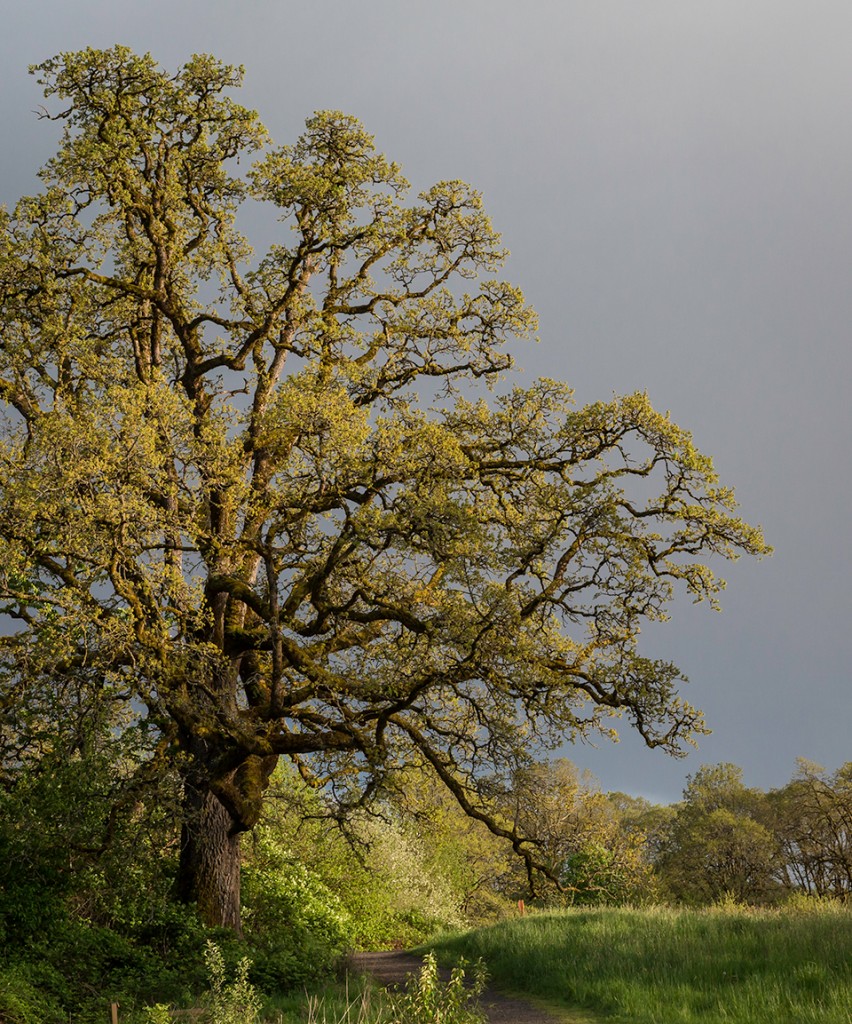
Get out your pencils and notebooks, class. It’s time for Anatomy Lesson One: Structure of a Functional Garden.
Just as our bodies’ structure relies on interconnected units like bone and muscle, so do ecosystems and the little parts of them we call gardens. The main framework of a garden (above the soil line) is made up of the obvious counterpart to bone—woody plants, like trees and shrubs, as well as manmade elements like buildings, fencing, and pergolas. A site’s location and topographical features, such as steep slopes or rocky outcrops, can also have a substantial effect on its structure.
There’s quite a bit of similarity between bone and wood; both have the ability to provide function as well as beauty (as revealed in this quip by the saucy Miss Trixie Delight, played by Madeline Kahn in Paper Moon: “When I was your age, I didn’t have no bone structure. Took me years to get bone structure. And don’t think bone structure’s not important!”). It’s beyond important, Trixie—a strong skeletal system is crucial. And, yes, it does take years to arrive; so the sooner you get a start on structure, the better.
When ecologists speak of structure they’re concerned with the entire community of species existing in a particular area, as well as nonliving components like rock and water. This post focuses mainly on living structure that provides a garden’s framework, as well as habitat for wild ones.
Seasonal interest
A garden should be a place we want to go to no matter the time of year, and structure provides the invitation. It’s helpful for creating gradual transitions, for dictating  how our eyes travel through a space, for providing unity, balance, and crucial wildlife habitat. And structure can rev up “curb appeal”: A house looks best when it softly blends into a landscape and one way to do that is by nestling it within or framing it with medium to large trees (size being dependent on the dimension of your house and yard), but not completely hiding it. Trees should be planted a minimum of ten feet from buildings, preferably more. They offer myriad other benefits, like shade on sultry summer days (particularly when placed to the southwest of a house), protection of the soil, mitigation against climate disaster, and improved drainage for other plants tucked underneath. Besides structure, native trees and shrubs provide essential food and shelter for both flora and fauna.
how our eyes travel through a space, for providing unity, balance, and crucial wildlife habitat. And structure can rev up “curb appeal”: A house looks best when it softly blends into a landscape and one way to do that is by nestling it within or framing it with medium to large trees (size being dependent on the dimension of your house and yard), but not completely hiding it. Trees should be planted a minimum of ten feet from buildings, preferably more. They offer myriad other benefits, like shade on sultry summer days (particularly when placed to the southwest of a house), protection of the soil, mitigation against climate disaster, and improved drainage for other plants tucked underneath. Besides structure, native trees and shrubs provide essential food and shelter for both flora and fauna.
Life does not occur in isolation
Other interconnected elements contribute to landscape structure, just as tendons, ligaments, and fascia contribute to ours. A single tree in a sea of lawn will not attract and support nearly the number of species that a grouping of trees, shrubs, and smaller plants will, nor will it create the same amount of interest for us. Beneath trees (but not too close to trunks) grow shrubs and perennials—in a layered effect—that will provide vertical and horizontal connections. This creates a natural look and provides safe cover for feeding, resting, or wandering wildlife. Nature likes to get all tangled up so that order looks a bit chaotic, so don’t be afraid to grow plants fairly close together as you’d see in the natural world; I recommend slightly closer than mature width apart to facilitate a bit of overlap.
Non-living elements, like arbors, trellises, water features, snags, nest boxes and even spider webs can add to the skeletal framework of the garden and provide ecological function, such as by supporting vines. I’m currently training a lovely pink-flowered, fuzzy-leaved native honeysuckle (Lonicera hispidula) on a large trellis that obscures the compost bins under our deck, and I have big plans for its orange cousin, Lonicera ciliosa, to clamber up a native rose. No doubt  the bees and hummingbirds will be very pleased with their flowers. Keep manmade elements to a minimum and keep them simple to achieve a sense of flow and to complement—not overpower—the plants.
the bees and hummingbirds will be very pleased with their flowers. Keep manmade elements to a minimum and keep them simple to achieve a sense of flow and to complement—not overpower—the plants.
If there’s a garden (or natural area) that you are particularly fond of, chances are it’s because it has a pleasing framework to which other landscape elements are connected. Like the myriad connections in our bodies, structure helps bring cohesion to a landscape.
To leave a comment, please click on the blog’s title